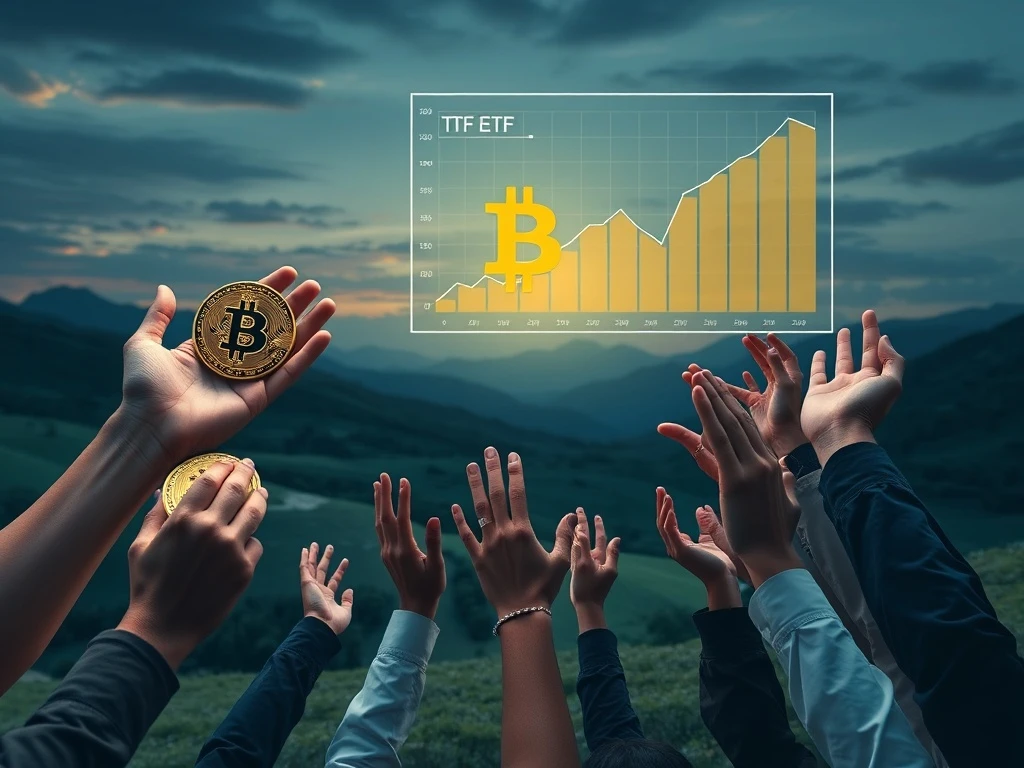Bitcoin ETF Demand: Massive Shift as Retail Investors Pile In

Are Bitcoin retail investors gone? Onchain data might suggest reduced activity from smaller wallets, leading some to believe retail demand has vanished. However, analysts propose a different picture: retail investors haven’t disappeared; they’ve simply changed how they access Bitcoin. A significant portion of this activity is now flowing through traditional finance channels, particularly via the booming **Bitcoin ETF** market. This shift is fundamentally altering how we understand **Bitcoin demand** and the market structure.
Spot Bitcoin ETF Growth and Retail Investors
Since their U.S. launch in January 2024, spot **Bitcoin ETF** products have rapidly accumulated assets. These ETFs offer a familiar and regulated way for individuals and institutions to gain exposure to Bitcoin without the complexities of self-custody. While institutions like investment advisors, hedge funds, banks, and pension funds are major holders, a significant portion of the underlying beneficiaries are **retail investors**.
Bloomberg analyst Eric Balchunas highlights that investment advisors account for nearly half of the reported assets in 13F filings by ETF holders. Hedge funds follow, with brokerages and holding companies also holding substantial amounts. Data from CoinShares shows firms like Goldman Sachs and Millennium Management holding significant positions.
Are ETFs Just Another Form of Retail Investment?
It’s easy to view ETF flows as purely institutional, distinct from the direct, self-custody approach often associated with early **retail investors**. While direct onchain activity from small wallets is low, suggesting a decline in that specific type of **Bitcoin demand**, the picture changes when considering ETFs. André Dragosch from Bitwise notes that while retail has been a distributor of Bitcoin directly, their participation is heavily expressed via ETFs/ETPs.
Dragosch estimates that **retail investors** account for close to 75% of the participants in U.S. spot Bitcoin ETFs, based on recent 13F filings. This suggests that a large segment of retail interest is now channeled through these investment vehicles. The success of products like BlackRock’s IBIT, which has generated significant revenue, underscores this point. This new reality means that assessing **Bitcoin demand** solely through onchain metrics might be incomplete; the growth in **Spot Bitcoin ETF** assets is a crucial indicator of continued, albeit re-routed, retail interest.
Understanding Current Bitcoin Market Dynamics
Despite the strong inflows into **Spot Bitcoin ETF** products, Bitcoin’s price has not yet reached new all-time highs. Data from CryptoQuant illustrates this: while combined ETF and Strategy inflows were robust earlier in the year, total apparent demand has turned negative more recently. This indicates that current inflows are being offset by other market dynamics, such as selling pressure or outflows from other segments.
The market may require a significant catalyst, such as changes in macroeconomic conditions like interest rate cuts, to absorb the selling pressure and drive prices higher. Such catalysts would likely benefit institutions and their clients, highlighting their growing influence in the **Crypto Investment** ecosystem. Experts like Alexandre Stachtchenko of Paymium believe that retail will increasingly utilize traditional finance rails for their crypto investment.
The Future of Retail Crypto Investment
The shift towards ETFs for Bitcoin exposure is a significant trend, particularly in regulated markets like the US. For many, this approach simplifies **Crypto Investment** and aligns it with existing financial strategies.
However, this does not necessarily mean the end of direct retail participation, especially outside the US. In regions where access to traditional finance products is limited or where self-custody is prioritized for economic or political reasons, direct buying and holding of Bitcoin remains essential. So, while direct retail activity might seem quiet globally, it continues in specific contexts and could re-emerge more broadly under favorable market conditions.
Summary: A Changing Landscape for Bitcoin Demand
The narrative that **Bitcoin demand** from **retail investors** is gone appears incomplete. While onchain data suggests reduced activity from small, self-custody wallets, the explosive growth of the **Spot Bitcoin ETF** market indicates a significant shift in how retail accesses the asset. A substantial portion of ETF ownership ultimately represents retail capital, channeled through familiar investment structures. This evolution in **Crypto Investment** highlights the increasing integration of Bitcoin into traditional finance, changing the dynamics of the market and how we measure participation. While current inflows may not yet be enough to push Bitcoin to new highs amidst other market pressures, the continued accumulation via ETFs confirms that retail interest remains strong, albeit expressed through new avenues.








